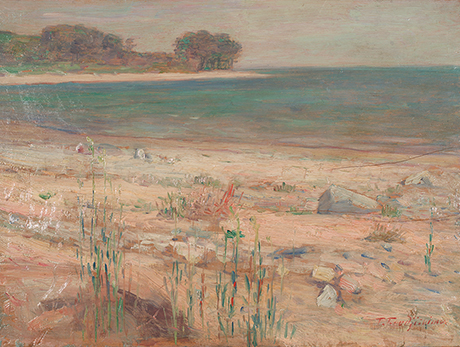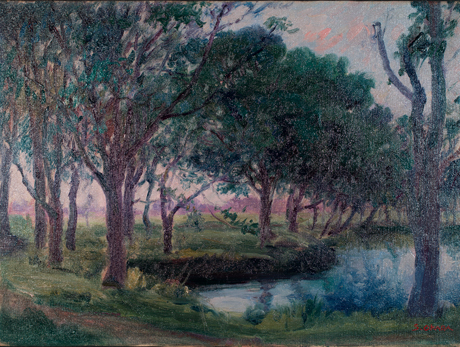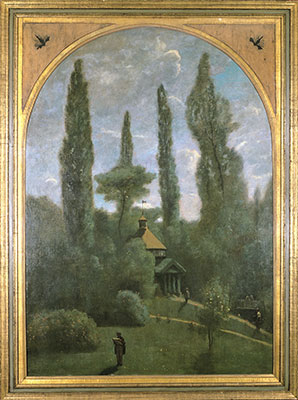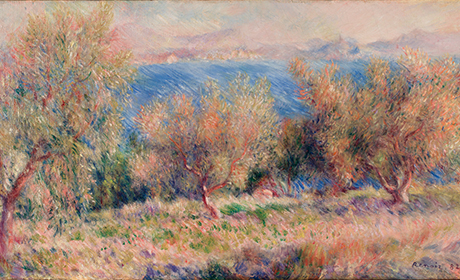
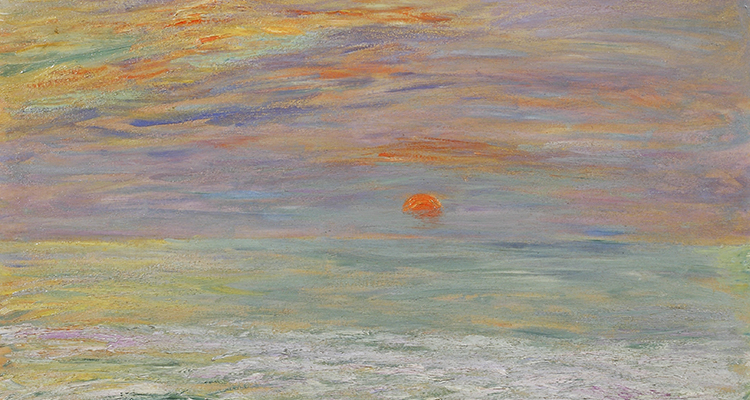
Exhibition
Marubeni Gallery Opening Exhibition Ⅰ
The Echoes of Modern Art between Japan and France
November 1, 2021 - January 31, 2022* Closed: Sundays/Public holidays/New year holiday season

About this Exhibition
This exhibition, entitled “The Echoes of Modern Art between Japan and France”, celebrates the opening of the new Marubeni Gallery. To represent the French side, we have selected the two French realism landscape paintings, one by Corot and one by Courbet, in addition to works by French impressionists, symbolists and fauvists such as Renoir, Redon, Dufy, and Vlaminck. Representing the Japanese side, we have selected pieces by such painters as Fujishima Takeji, Okada Saburosuke, Wada Eisaku, Kawashima Riichiro, Umehara Ryuzaburo, Yasui Sotaro, Koiso Ryohei, and Ogisu (Oguiss) Takanori. All of these artists were strongly influenced by French modern artists in the late 19th and 20th centuries. Free from traditional classification, we are exhibiting these works from the Marubeni Collection according to such elements as styles of brushstrokes, colors, and so on. In this way, we review the artistic exchanges, or echoes, between France and Japan in modern and contemporary painting.
Prominent Works to be Displayed
Beach
Fujishima Takeji (1867-1943)
1898 Oil on panel 24×33cm
Fujishima Takeji was born in Kagoshima Prefecture, Japan. In 1884, Fujishima moved to Tokyo, where he became a pupil of Kawabata Gyokusho and studied Japanese traditional painting. However, he later switched to Western-style painting, which he studied under Soyama Sachihiko and Yamamoto Hosui. With the recommendation of Kuroda Seiki, Fujishima became an assistant professor at Tokyo Fine Arts School in 1896. In the same year, he joined the White Horse Society (Hakuba-kai), which was founded by a group of artists that included Kuroda. In 1906, Fujishima traveled to Europe and studied under Fernand Cormon in France and Carolus Duran in Italy. Cormon's specialty was historical paintings, while Duran excelled in portraits. Upon his return to Japan in 1910, Fujishima was appointed professor at Tokyo Fine Arts School. He was a recipient of the very first Order of Culture from the Japanese Government in 1937.
This painting depicts a sandy beach, with weeds in the foreground, a calm sea in the middle and Enoshima Island in the background. The painting’s colors are characteristic of Pleinairisme techniques.
Beside a swamp
Okada Saburosuke (1869-1939)
1919 Oil on canvas 34×46cm
Okada Saburosuke was born in Saga Prefecture, Japan. He started as a painter in 1887, studying under Soyama Sachihiko, and became a member of the Meiji Art Association in 1891. Through Kume Keiichiro, Okada became acquainted with Kuroda Seiki, and joined the Tenshin Dojo. In 1896, Okada was appointed assistant professor at Tokyo Fine Arts School and became a founding member of the White Horse Society (Hakuba-kai) that was presided over by Kuroda Seiki. In the following year, Okada traveled to France and studied under Rafael Collin as Kuroda Seiki had done. Upon his return to Japan in 1902, he became a professor at Tokyo Fine Arts School. In 1912, he partnered with Fujishima Takeji to found the Hongo Institute of Painting, where he trained a large school of painters. He was a recipient of the very first Order of Culture from the Japanese Government in 1937.
In this image of a swamp painted in 1919, we can see traces of his master Raphael Collin, a painter of the Pleinairisme school, in the clear colors which receive the cool, morning light, in the elegant purple used in the background, and in the trunks of the trees.
The arbor of Ville-d’Avray
Jean-Baptiste-Camille Corot (1796-1875)
1847 Oil on canvas 150×110cm
Corot was born in Paris, France and died in the nearby town of Ville-d'Avray. Beginning in 1822, he studied the classical approach to historical landscape painting under Achille-Etna Michallon, but on the advice of his master, he also frequented the forest of Fontainebleau with his sketchbook to study directly from nature itself. Corot traveled very often to Italy where he composed many paintings, soaking up the intellectual atmosphere and classic lines of Rome and the countryside nearby. From these many influences, Corot was able to produce not only realism landscapes but also landscapes of various styles, including classical landscapes and lyrical ones. Corot’s landscapes became particularly poetic and lyrical from around 1850, when he exhibited his 《Morning, Dance of the Nymphs》 at the Salon.
During the summer of 1847, when Corot spent considerable time at his father’s house in Ville-d'Avray to remain close to his father who was sick. He decorated the walls of a small garden gazebo with a series of six landscape compositions. This painting is from that series. Corot produced this work for his mother's birthday; the foreground figure, behatted and reading a newspaper against the sunlight, is the artist's father. The two ladies, chatting as they lean on the handrail of a rustic bridge in the background at the right, are thought to be his mother and elder sister. Corot himself can be seen returning from a sketching expedition, carrying a portfolio under his arm. Meanwhile, in the center of the painting, waiting to welcome the painter on the path in front of the kiosk, or pavilion, is Mr. Sennegon, the husband of Corot's elder sister.
The olive groves of l'Estaque
Pierre-Auguste Renoir (1841-1919)
1882 Oil on canvas 94×36cm
Renoir was born in central France, in the town of Limoges. He began working as an apprentice painter at the age of 13, painting decorative motifs on china. Later, he attended Gleyre’s studio, and then entered the École des Beaux-Arts in Paris, where he made friends with Monet, Sisley, and other artists. His early works show influence from Delacroix and Courbet. In 1864, his painting was accepted for the first time at the Salon, but he was soon helping to establish a new movement called Impressionism, and thus displayed masterpieces at the first, second and third Impressionist exhibitions. Among the great works of the early years were 《The Theater Box》 (1874) and 《The Dance at Le Moulin de la Galette》 (1876). In 1881-82 Renoir traveled to Algeria and to Italy. In the end of January 1882, on his return journey from Italy, Renoir visited L'Estaque, staying at a hotel overlooking the sea. There, he got to spend time with Cézanne, a painter whom he respected.
In this painting, Renoir’s treatment of the sea and olive grove with oblique paralleled strokes appears to echo the technique of Cézanne. The season was in fact winter when Renoir painted this piece, but the air was spring-like, clear, and bright. Sunlight pours over the painting, soaking into the foliage of the olive trees and spraying into the atmosphere. "Spring without wind, just peaceful sunshine," he wrote to the art dealer, Durand-Ruel, "This is pretty rare in Marseille." This painting was displayed at the exhibition held at the Metropolitan Museum of Art in New York in 1937.




